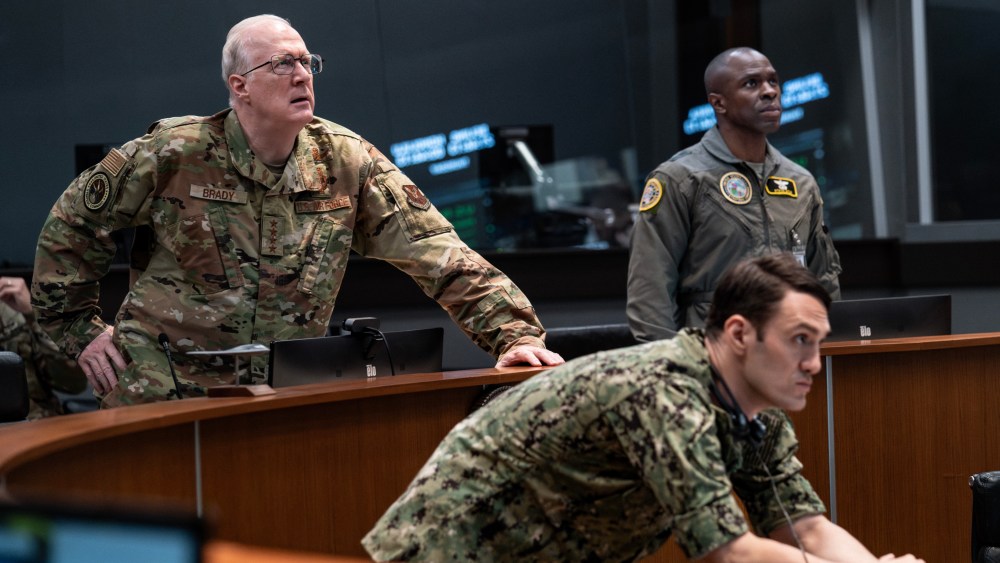Directed by Kathryn Bigelow, The House of Dynamite is filled with unsettling tension from start to finish as it follows the imminent threat of a nuclear missile hurtling toward the United States. The tension and anxiety that drives it is largely due to the team of craftsmen, including composer Volker Bertelmann, editor Kirk Baxter, and sound designer Paul Ottosson, who brought their respective skills to work closely behind the scenes to bring this piece together.
Bigelow’s film, currently streaming on Netflix, is divided into three chapters and tells the story from three different perspectives. It all begins in the White House crisis room, with Captain Olivia Walker (Rebecca Ferguson) working with Major Daniel Gonzalez (Anthony Ramos) and his team at a military base in Alaska. Once a missile comes your way, you have 20 minutes to react accordingly.

Eros Hoagland/Netflix
Ottosson says reading the script itself was an unsettling experience. “I was very nervous while reading it. It had a different structure and I was curious to see how it would come together,” he says. Bertelmann recognized the need to develop the score with each chapter. “You have to have something in your pocket to increase the tension,” he says. “The opening presents us with a whole musical palette of what we can expect and what kind of movie this is going to be. When you hear the first notes, you know where we are. We’re not in a romance. We’re in a thriller, and it’s going to be very dark in some parts.” But it took several tries to get the first moment right. Bertelmann said he worked on shaping the score and took a few steps back before moving on to the second chapter.
In cutting those moments, Baxter used the score to track the temperature of the edit, especially as the second chapter begins. Baxter said, “[Bertelmann’s]score peaks and resets at the end of the first chapter. You get hints coming in from little voices.” He added that the idea was to make the audience wonder what would happen next. Is it the aftermath of a missile collision? Instead, he says, “those sprinkles start and then you go back into panic mode and it stays that way. The score tells you right away that you’re in that state.”
Ottosson’s approach was to look at the sound chapter by chapter. “In Chapters 1 and 2, people are confident and educated and doing things. But, of course, sometimes things go wrong. You can’t control the environment, so I tried to make it louder.” In Chapter 2, we reset everything to the beginning of the day to show even more departments. In Chapter 3, the focus returns to the Oval Office. This time, the face of Idris Elba, who we only knew from the black box, has been revealed. When the day is reset at the end of the film, his scenes throw humanity into chaos.
“For the first chapter, we stayed with Rebecca and focused on Volker’s music,” says Baxter. The third chapter, which switches to the president’s point of view, depicts the human experience and “one man’s decisions. The silence and Volker’s music are what really make this work so great. The confusion at the beginning helps us understand the delicate human elements of the third chapter.”
The decision not to reveal him sooner was always intentional. “I spent a lot of time on the black square and leaning into it,” Baxter says. “Especially in the second chapter, when you’re just sitting there waiting for an answer. The shot is just patient, just silent. It feels like you’re looking down a well. The anticipation builds to see him and hear the answer.”

The final chapter delves deeply into the president’s emotional state of mind. He is the last man to make the decision. “He also has to deal with human issues and there’s a lot of things that can go wrong and he’s emotional,” Baxter explains. Much of the story was written and scripted by screenwriter Noah Oppenheim, but several moments came together during editing. An example of this is the president’s phone call with Russia in chapter 3. “It wasn’t written to be on for the whole time because we’ve had that experience before. The page said, ‘You don’t have to listen to that entire conversation again.’ But on the President’s trip, the joy of reliving it is evident on his face, and it amplifies all that tension of, “I need some time,” to go to Africa. ”
Suddenly, the sound of Ottoson’s elephants is accompanied by a wide shot of his wife on a safari. He said, “It kind of puts pressure on that scene to want to have that connection between people, just like humanity as a whole.”
The craftsmen also had access to military advisor Dan Kabler at any time. Trusting Karbler’s advice, Ottosson says, “It was important to stay true to what could happen in these rooms and situations. We never thought about cool sounds in terms of how they would sound. It was, ‘What would it feel like in this situation and what would it sound like?'”

